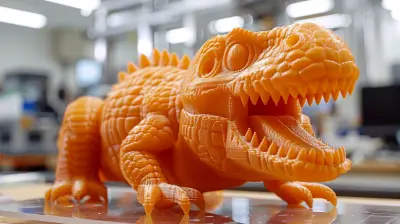Why Early Exposure to STEM is Important for Kids
19 December 2024
In today’s fast-paced, tech-driven world, STEM (Science, Technology, Engineering, and Mathematics) is more than just a buzzword. It’s become a cornerstone of modern education, shaping the future of industries and innovations. But why is it so crucial to expose children to STEM at an early age? What impact does it have on their growth, learning, and future success?
Let’s dive into why giving kids an early introduction to STEM subjects is a game-changer and how it can shape their mindset, problem-solving abilities, and even their career paths.
What is STEM Education?
Before we jump into the why, let's make sure we understand the what. STEM stands for Science, Technology, Engineering, and Mathematics. It’s a multidisciplinary approach to education that integrates these four subjects into a cohesive learning model. Instead of teaching these fields in isolation, STEM education emphasizes their real-world applications and interconnectivity.For instance, a typical STEM project might involve building a robot (engineering) that can perform tasks based on programmed instructions (technology), all while calculating angles or force (math) and understanding how sensors work (science). It’s about hands-on learning and critical thinking, not just memorizing facts from a textbook.
Why Early Exposure Matters
1. Fosters Curiosity and Creativity
Children are natural-born explorers. They ask a million “why” questions, and sometimes their imagination seems limitless. Early exposure to STEM taps into this curiosity by encouraging kids to think creatively about the world around them.STEM activities often involve experimentation—asking questions, making predictions, testing theories, and observing outcomes. This kind of problem-solving is not only engaging but also helps kids develop a mindset that embraces exploration. By learning to ask questions, they start thinking like scientists, engineers, or mathematicians. It’s almost like giving them the keys to unlock their own creativity.
2. Builds Problem-Solving Skills
Let’s be real—life is full of challenges. Whether it’s figuring out how to tie your shoes, solve a complex math problem, or navigate a tricky social situation, problem-solving is a skill that everyone needs. The good news? STEM is all about solving problems.When kids engage in STEM activities, they learn how to approach an issue methodically. They identify the problem, brainstorm possible solutions, test their ideas, and then refine them based on the results. This process teaches them resilience and patience—important traits when tackling life’s inevitable roadblocks.
Imagine a child building a bridge out of toy blocks. The bridge collapses the first time, but instead of giving up, the child tries again, tweaking their design each time. That’s problem-solving in action, and early STEM exposure makes it second nature.
3. Encourages Collaboration and Teamwork
Contrary to popular belief, STEM isn’t a solo endeavor. Many STEM activities require collaboration, which teaches kids the value of teamwork. Whether they’re working on a science experiment, coding a simple game, or building a structure, STEM projects often involve working with others, sharing ideas, and coming to collective solutions.This sense of collaboration mirrors real-world scenarios where professionals—whether they’re doctors, engineers, or software developers—work together to solve complex problems. By introducing these cooperative activities early, children learn how to communicate effectively and appreciate different perspectives, setting them up for success in both academic and social environments.
4. Develops Critical Thinking
Critical thinking is the ability to analyze situations logically, consider different viewpoints, and make informed decisions. It’s a skill that’s highly valued in nearly every profession.In STEM education, kids are constantly asked to think critically. They’re encouraged to question assumptions, analyze data, and draw conclusions based on evidence. Whether they’re figuring out how to make a paper airplane fly farther or investigating why a plant grows faster in sunlight, they’re honing their critical thinking skills.
Think of STEM as a mental gym. The more kids engage in these kinds of activities, the stronger their “thinking muscles” become. And just like physical muscles, the earlier you start building them, the better.
5. Prepares Kids for Future Careers
The job market is changing rapidly, and STEM careers are on the rise. In fact, according to the U.S. Bureau of Labor Statistics, STEM jobs are projected to grow significantly faster than non-STEM jobs in the coming years.By exposing kids to STEM early on, you’re giving them a head start in exploring potential career paths. Whether they end up becoming a software developer, data scientist, engineer, or even a medical professional, early STEM exposure helps kids develop a foundation in fields that are not only in high demand but also offer lucrative opportunities.
But even if your child doesn’t pursue a STEM career, the skills they learn—like critical thinking, problem-solving, and collaboration—are valuable in any profession. It’s about giving them the tools to succeed in an increasingly technological world.
6. Instills Confidence and a Growth Mindset
Let’s face it—STEM can be challenging, especially for kids who are just starting out. But that’s the beauty of it. By tackling those challenges, kids learn that failure is not the end—it’s just a step in the learning process.In STEM, failure is often seen as a positive thing. It’s an opportunity to learn, adapt, and try again. This builds a growth mindset, where kids understand that their abilities can improve with effort and persistence. As they succeed in small tasks, their confidence grows, and they become more willing to take on bigger challenges.
This is a mindset that extends far beyond STEM. Whether they’re facing academic difficulties, personal struggles, or career challenges, the resilience they develop through early STEM exposure will help them navigate life’s ups and downs with confidence.
How to Introduce STEM to Kids
Now that we’ve established why early exposure to STEM is important, let’s talk about how you can introduce it to your kids in a fun and engaging way.1. Start with Hands-On Projects
Kids learn best by doing. Introduce them to simple, hands-on STEM projects that spark their curiosity. For example, you can build a volcano using baking soda and vinegar or create a simple circuit using batteries and light bulbs. These activities don’t just teach scientific concepts—they make learning fun.2. Encourage Questions
When your child asks, “Why is the sky blue?” or “How does a car move?”, use it as an opportunity to explore STEM concepts. You don’t need to have all the answers right away. In fact, it’s more beneficial to encourage your child to investigate the answers with you. Look up articles, watch videos, or conduct simple experiments together.3. Use Everyday Objects
STEM learning doesn’t require expensive kits or complicated tools. You can use everyday objects to teach STEM concepts. For instance, cooking is a great way to introduce math (measuring ingredients) and science (how heat changes food). Building with LEGO bricks can teach engineering basics, while playing with apps or games can introduce technology and coding.4. Explore STEM Toys and Apps
There are plenty of toys and apps designed to introduce kids to STEM concepts. Look for age-appropriate tools like coding games, engineering kits, or science experiment sets. These toys often make learning feel like play, which is key to keeping kids engaged.5. Make it Fun and Relevant
Kids are more likely to get excited about STEM if they see how it applies to their lives. Help them make connections between STEM and the world around them. For example, you can talk about how engineers design roller coasters or how doctors use technology to save lives. When they see the real-world impact of STEM, they’ll be more motivated to explore it further.
The Future is Bright with STEM
In a world that’s becoming increasingly reliant on technology, early exposure to STEM is more important than ever. It’s not just about preparing kids for future jobs—it’s about equipping them with the skills they need to navigate a complex, ever-changing world.By fostering creativity, developing problem-solving skills, and encouraging collaboration, STEM gives kids the tools to succeed in all areas of life. And the best part? It’s never too early to start.
So, whether you’re a parent, teacher, or just someone who cares about the future of the next generation, consider introducing kids to STEM early on. You might just be helping to shape the innovators, thinkers, and problem-solvers of tomorrow.
all images in this post were generated using AI tools
Category:
Child DevelopmentAuthor:

Olivia Lewis
Discussion
rate this article
18 comments
Logan Whitley
Early STEM exposure fosters critical thinking and problem-solving skills essential for future success.
March 17, 2025 at 8:48 PM

Olivia Lewis
Absolutely! Early STEM exposure equips children with vital skills, paving the way for innovative thinking and effective problem-solving in their future endeavors.
Nellie Hurst
Early exposure to STEM fosters critical thinking and creativity in children, laying a strong foundation for future learning. It encourages curiosity and problem-solving skills, essential for navigating an increasingly complex world. Investing in STEM today shapes innovative thinkers for tomorrow.
February 22, 2025 at 3:34 AM

Olivia Lewis
Thank you for summarizing the importance of early STEM exposure! It truly is vital for nurturing the next generation of innovative thinkers and problem-solvers.
Celeste Morgan
Great article! Early exposure to STEM empowers kids with critical thinking and problem-solving skills, preparing them for a future filled with opportunities. Inspiring young minds now will undoubtedly lead to innovative leaders tomorrow. Keep up the fantastic work!
February 12, 2025 at 1:04 PM

Olivia Lewis
Thank you for your kind words! I'm glad you enjoyed the article and share the belief in the power of early STEM education.
Azurael McDowell
Early exposure to STEM isn't just beneficial—it's essential. Ignoring it risks stunting our children's potential. Let's empower them with the skills they'll need to thrive in an ever-evolving world.
February 2, 2025 at 7:34 PM

Olivia Lewis
Absolutely! Early STEM exposure is crucial for fostering critical thinking and problem-solving skills in children, setting a strong foundation for their future success.
Brooke McFarlin
Early STEM exposure fosters creativity and critical thinking skills.
January 27, 2025 at 1:08 PM

Olivia Lewis
Absolutely! Early STEM exposure engages young minds, encouraging innovative thinking and problem-solving abilities that are essential for future success.
Zephyrwind McGee
Early STEM exposure fosters critical thinking and problem-solving skills in children.
January 22, 2025 at 5:56 AM

Olivia Lewis
Absolutely! Early STEM exposure not only enhances critical thinking and problem-solving abilities but also ignites curiosity and creativity, laying a strong foundation for future learning.
Hannah Rios
Thank you for highlighting the significance of early STEM exposure! It’s heartening to see how nurturing curiosity in young minds can shape their future. By fostering problem-solving skills and creativity, we empower our children to thrive in a rapidly evolving world. Let's inspire the next generation together!
January 15, 2025 at 3:43 AM

Olivia Lewis
Thank you for your thoughtful comment! I completely agree – nurturing curiosity and creativity in young minds is crucial for their future success in STEM fields. Let's keep inspiring the next generation together!
Dylan Ruiz
Early exposure to STEM fosters critical thinking, creativity, and problem-solving skills in children. By engaging with science, technology, engineering, and mathematics, kids develop a strong foundation that prepares them for future academic and career opportunities.
January 7, 2025 at 9:51 PM

Olivia Lewis
Absolutely! Early exposure to STEM not only enhances critical skills but also equips children with a solid base for future success in various fields.
Greta Pratt
Empower young minds, ignite futures!
January 3, 2025 at 1:08 PM

Olivia Lewis
Absolutely! Early exposure to STEM fosters curiosity, creativity, and critical thinking, setting the foundation for a bright future.
Soryn McClure
Early exposure to STEM is crucial for children's development, fostering critical thinking and problem-solving skills. It cultivates curiosity and innovation, preparing them for future challenges. However, it's important to ensure that learning remains engaging and accessible, allowing all children to explore their interests in a supportive environment.
December 29, 2024 at 5:38 AM

Olivia Lewis
Thank you for highlighting the significance of engaging and accessible STEM education. It truly lays the foundation for critical skills and fosters a lifelong love of learning in children.
Xavi Shaffer
Exposing kids to STEM early is like giving them the keys to a magical toolbox! Who knew that building a rocket in the backyard could spark a future career in NASA? Just remember: no rocket science without a little fun first!
December 25, 2024 at 9:58 PM

Olivia Lewis
Absolutely! Early STEM exposure opens up endless possibilities and makes learning engaging and fun. It lays the foundation for creativity and innovation in future careers!
Uma Horne
Early exposure to STEM empowers children to explore, innovate, and think critically. It ignites their curiosity and passion for learning, laying a strong foundation for future success. By nurturing these skills from a young age, we equip the next generation to tackle challenges and shape a brighter world.
December 22, 2024 at 7:31 PM

Olivia Lewis
Absolutely! Early STEM exposure is crucial for fostering creativity, critical thinking, and problem-solving skills in children, setting them up for future success and innovation.
Jacob Whitley
Thank you for this insightful article! Early exposure to STEM truly nurtures curiosity and creativity in children, laying a strong foundation for their future learning and problem-solving skills.
December 21, 2024 at 11:29 AM

Olivia Lewis
Thank you for your thoughtful comment! I'm glad you found the article valuable. Early exposure to STEM indeed plays a crucial role in fostering curiosity and creativity in young learners.
Valeria Middleton
Early exposure to STEM fosters critical thinking, problem-solving skills, and creativity in children. By introducing these concepts at a young age, we equip future generations with essential tools for success in an increasingly technology-driven world.
December 21, 2024 at 4:48 AM

Olivia Lewis
Absolutely! Early STEM exposure indeed nurtures essential skills that prepare children for future challenges in a tech-driven landscape.
Arden McMahon
Great insights! Essential for future success!
December 20, 2024 at 7:22 PM

Olivia Lewis
Thank you! I'm glad you found it insightful. Early STEM exposure really sets the foundation for future success!
Ashley Black
Great article! Early STEM exposure truly empowers kids, sparking curiosity and laying a strong foundation for success.
December 20, 2024 at 12:11 PM

Olivia Lewis
Thank you! I'm glad you found it insightful. Early STEM exposure indeed plays a crucial role in fostering curiosity and building a strong foundation for future success.
Vera Moses
Empower young minds, ignite limitless potential!
December 19, 2024 at 8:16 PM

Olivia Lewis
Absolutely! Early exposure to STEM cultivates creativity and critical thinking, unlocking the vast potential within every child.
Xena Banks
Early exposure to STEM not only ignites curiosity but also empowers kids to think critically and creatively. By nurturing their interests in science, technology, engineering, and math, we lay the foundation for lifelong learning and innovation. Let’s inspire the next generation to explore, invent, and shape the future with confidence!
December 19, 2024 at 4:34 AM

Olivia Lewis
Absolutely! Early STEM exposure fosters curiosity and critical thinking, equipping kids with essential skills for future innovation. Let's empower them to explore and shape a bright future!
MORE POSTS

How Assistive Technologies are Supporting Students with Disabilities

How to Integrate 3D Printing into STEM Projects

Exploring Abstract vs. Realism: Helping Students Find Their Style

Encouraging Girls to Participate in Physical Education

Rethinking Assessment in Inquiry-Based Learning"

How to Make the Most of Study Time During the Holidays

The Role of Positive Reinforcement in Study Habits

How to Use Virtual Labs to Teach Science Concepts"

Addressing Trauma in the Classroom with SEL Approaches

How to Develop a Culturally Responsive PE Curriculum

The Teacher's Role in Nurturing Multiple Learning Styles